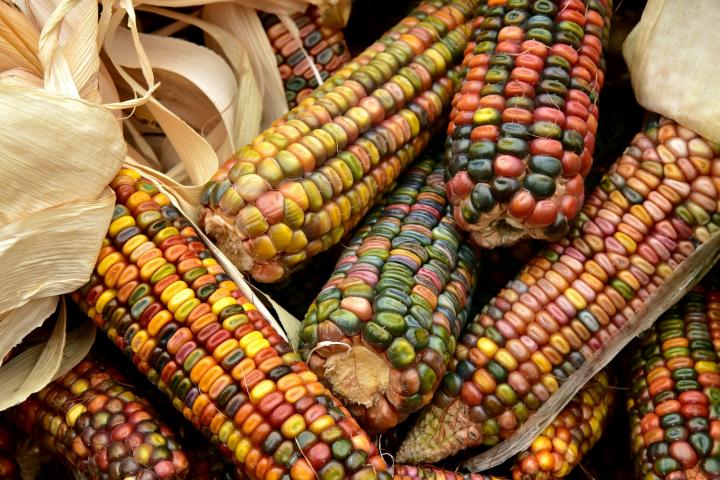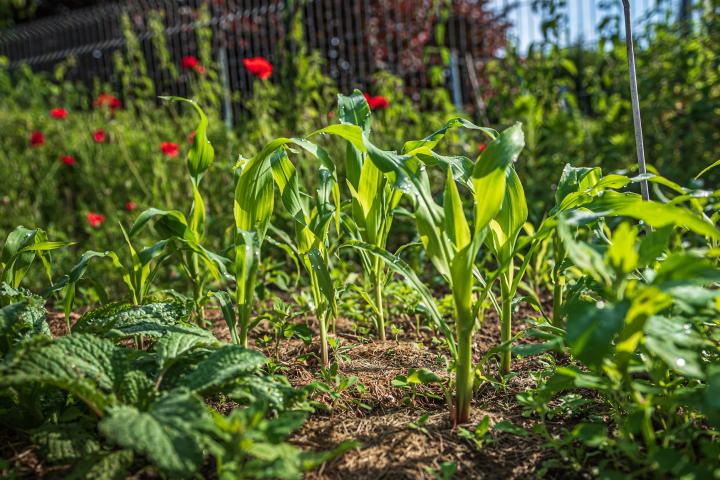
Planting, Growing, and Harvesting Sweet Corn
Read Next
Types
Types of Sweet Corn
There are four main types of hybrid sweet corn: sugary (su), sugar-enhanced (se), shrunken (sh, sh2), and synergistic (sy). Each one contains a different level of sucrose, changing the flavor and texture of the corn. The type of corn will be listed right on the seed packet.
It’s important to be aware of which type of corn you’re growing—not only because of the sugar content, but also due to how easily the types can cross-pollinate. If the wrong combination of types cross-pollinates, the ears that are produced may be of subpar quality.
- Sugary (su) sweet corn is the classic sweet corn. Sugary varieties grow vigorously and are stress resistant. The kernels aren’t too sweet and are said to have a “traditional” taste. However, the sugars in sugary sweet corn quickly turn to starch after the ears are picked, so they need to be eaten right after picking. Do not plant near shrunken or synergistic types.
- Sugar-enhanced (se) sweet corn is slightly sweeter than sugary varieties. They keep their sweetness for a longer period of time after harvest (a few days) than sugary varieties. They grow well with few issues. Do not plant near shrunken types.
- Shrunken (sh, sh2) sweet corn—also called “supersweet”—are the sweetest varieties, containing two to three times more sugar than sugary varieties. The sugar in their kernels lasts even longer after harvest (up to a week) than the other types, but kernels tend to be more crunchy and not taste as “corny.” Shrunken types are also more finicky overall. Do not plant them near any other types; hybrid kernels turn out starchy and tough.
- Synergistic (sy) sweet corn combines sugar-enhanced with one of the other two types to create varieties that have the best of both worlds. Synergistic types tend to have very sweet, tender kernels with a good taste and some synergistic varieties can keep up to a week after harvest. Do not plant near sugary or shrunken types.
Recommended varieties include:
- ‘Argent’: sugar-enhanced variety, good taste. White kernels.
- ‘Iochief’: midseason, normal-sugar variety. Yellow kernels.
- ‘Luther Hill’: dwarf, normal-sugar variety. Produces 4- to 6-inch ears on 4- to 5-foot stalks. White kernels. Grow at least nine dwarf plants in a block of three or four rows.
- ‘Silver Queen’: normal-sugar variety. Resistant to some bacterial diseases. White kernels.
- ‘Sweet Sunshine’: supersweet variety. Disease resistant and high yield. Yellow kernels.
Corn can be a feast for the eyes, too! Look for these ornamental varieties:
- ‘Glass Gem’: Sporting multi-colored, semi-transparent kernels, this is a favorite for kids.
- ‘Painted Mountain’: Looking for the classic “maize” colors? This variety has a great diversity of natural tones. Check out our video to learn more about growing and using painted mountain corn.

Gardening Products
Cooking Notes
- If too much hot pepper or spice has been added to a soup or stew, adding a can of sweet corn can help.
- Popcorn is also a favorite snack if you have leftover kernels. Learn how to make homemade popcorn here.
More Like This
If you have tassels, it's not pollination. And if your corn looks tall and green but lacks ears, it might be overcrowded, and your plantings are too thick. However, the yellowing that you mention, plus the lack of ears, does indeed suggest nitrogen deficiency. It's hard for us to diagnose from afar, and you should call your local county extension services. In terms of a solution, there are mixed results on late-season nitrogen application for corn. If your corn already had a nice nitrogen application in fall/spring, and it's the weather called some leaching, it may work. If the corn lacked nitrogen all along, it probably wouldn't make up the yield. But you might as well try it. Here is a good reference from the Purdue extension.
Dear Ello,
Thank you for your note about your furry wild popcorn-loving neighbors. Yes, if the corn is ripe, you can dry the ears inside. Here is our guide to growing popcorn including advice for harvesting and drying. Good luck and happy popping!
—The Editors
You will want to remove the stalks soon after harvest. There are a number of pests that will use what remains after harvest as a winter home and by removing the stalks you will greatly reduce their chances of survival. But you have a few options of what to do with your stalks.
You can cut them down and put them in your compost pile. We suggest cutting them up some to increase the rate of decomposition. You will then want to till the stalk nubs back into the soil. You can also till all of it into the soil. There are a lot of great nutrients that remain in corn stalks and it will provide good organic matter for next year's plantings once it breaks down.
And if you want to think ahead, cut some of the stalks and dry them upside down and they will make for great decor when fall rolls around!
Hi, Louise. When you boil corn on the cob, allow the water to come to a full boil and then add in the ears of corn. Cook it for 5 minutes. When it comes to cooking corn on the cob on the grill there are several methods. Try this: peel the corn and remove the silk. Pull the husks back up and then soak the ears in salted water for about 10 minutes. Remove and make sure to shake off any excess water. Place the ears on the grill, close the lid, and turn every 6 minutes. Your corn should be ready after 20 minutes.
- « Previous
- 1
- 2
- …
- 10
- Next »












Comments